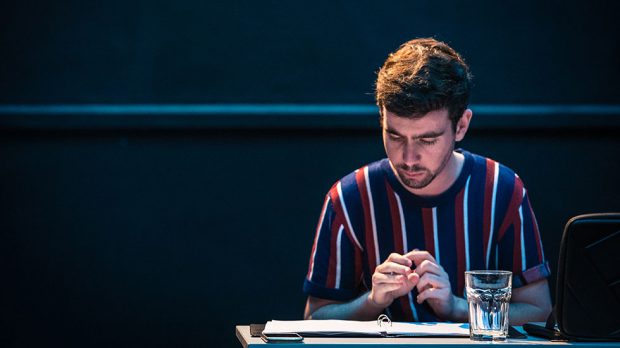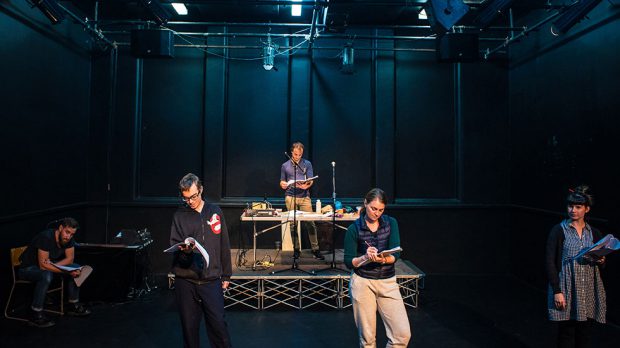
Laika allows audiences to take a glimpse behind the Iron Curtain, during the peak of the Cold War. The staged radio play, by the team at Second Chance Theatre, opens at The Blue Room on September 12. It’s set against the background of Soviet Russia’s drive to win the Space Race, and asks how much would you be willing to sacrifice to achieve your goals? DAVID O’CONNELL sat down to chat with writer/ director Scott McArdle and Foley artist Andrew David, about the famous dog’s fateful voyage, the peculiarities of the USSR’s cosmonaut program, and what does a Foley artist do. Laika is showing at The Blue Room from 12th September to the 30th September.
What was the inspiration for Laika?
SM: 3 years ago I was at home, it was 3am and trawling through Cracked (as I did when I was doing my Honours) and I came across an article Five Most Terrifying Things That Happened in Soviet Russia’s Space Program. I knew all at about NASA, I knew all about modern day space travel, but not a lot about the USSR side of the space race. One thing really chilled me was was the picture of the first batch of cosmonauts, but one of the cosmonauts had been doctored out of it. I delved a little deeper, and he had been doctored out after embarrassing himself in a drunken fight with a guard, and killed himself. Then going deeper-he wasn’t the only one. There was this conspiracy of the missing cosmonauts. One name kept coming up Sergei Pavlovich Korolev – the guy who was managing the program. I was fascinated and inspired, so I went down that rabbit hole, researched, and finally came around to the idea of Russia being the real winners to the space race.
I decided it was such beautiful material for a play, as not a lot of people know it.
How did you decide on a radio play?
SM: Originally it was going to be a musical.
[laughter] Well there’s a missed opportunity.
SM: I know…there goes my Tony Award.
I wrote the first act, and thought it was unauthentic. So put it on the back-burner.
So when we (Scott and Andrew) are talking about some of the radio plays we did at Murdoch, and realise that Laika was set during the golden age those plays – things actually started to come together.
Andrew, can I get you to explain what a Foley artist is?
AD: A Foley artist is the person that places all the sound effects back into a film. Footsteps, horse hooves, sword fights -all those sounds are done by a Foley artist in a studio watching the raw footage and putting those sounds back in, as you can’t capture that in filming. In the old radio plays they used to do everything in studio using practical effects. Like War of the Worlds (the infamous Orson Welles radio play which sparked large scale panic when it was broadcast). The big laser beam in War of the Worlds-those are practical effects people recorded in the studio.
It’s not simple.
SM: I disagree, you make it look very effortless.
AD: That is a lot of time spent at home thinking things out, and banging different things together. When you do it for film you have a studio and can audio-manipulate sounds afterward. Here you have to do rockets or a train with what we can hold at a table in front of a microphone.
So how do you stage a radio play as a piece of theater?
SM: So when we are on stage, the actors are in the foreground and Andrew is in the background with two tables filled with everyday equipment.
This is theatrical magic, this is a glimpse backstage. Suspend your disbelief and there’s something really beautiful. Every sound is done live.
So what is Laika about?
SM: The play span’s 1957-1966, and follows a fictional flight technician who’s “a fly on the wall”to a lot of key events in history. We start with the titular event (Laika’s fatal launch), carry on through to Yuri Gagarin’s First Man in Space launch, and go through to the infamous Soyuz One launch. It’s exploring what you sacrifice to gain greatness.
Andrew, what’s the strangest thing you use during this performance to produce a sound?
AD: Everything is kind of normalised for me.
SM: We’ve added one recently that is a balloon pushed up against the mike, and we squeeze it to sound like metal bending and contracting. Pop rocks and Coke as acid. A bike pump for a train.
AD: None of it seems weird to me as I’ve been playing around with it for months.
SM: It is all fucking weird.
Why are we seeing an emergence of genre pieces (science fiction and horror) in theatre in the last few years?
SM: I think science fiction interesting as to what you can show without it collapsing into B-grade. This (Laika) is science fact. The thing that’s underpinning my work is a sensed darkness and this play similarly dark.
We’ve got a generation writers that grew up on those story now. And the advent of technical theatre, allows you to create technically suave pieces.
AD: that availability of technology is opening more and more avenues for storytelling.
